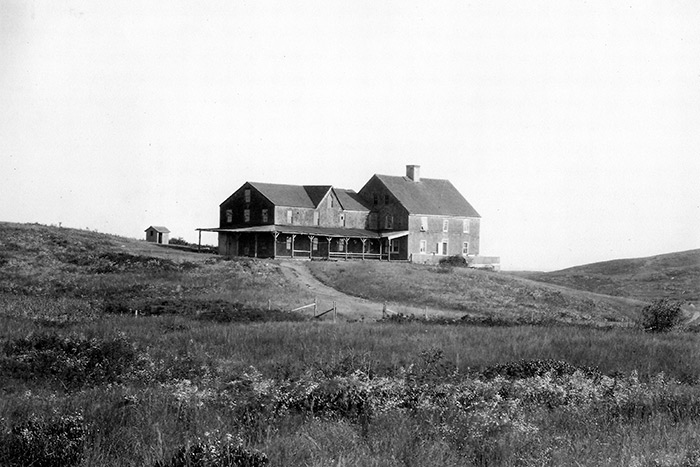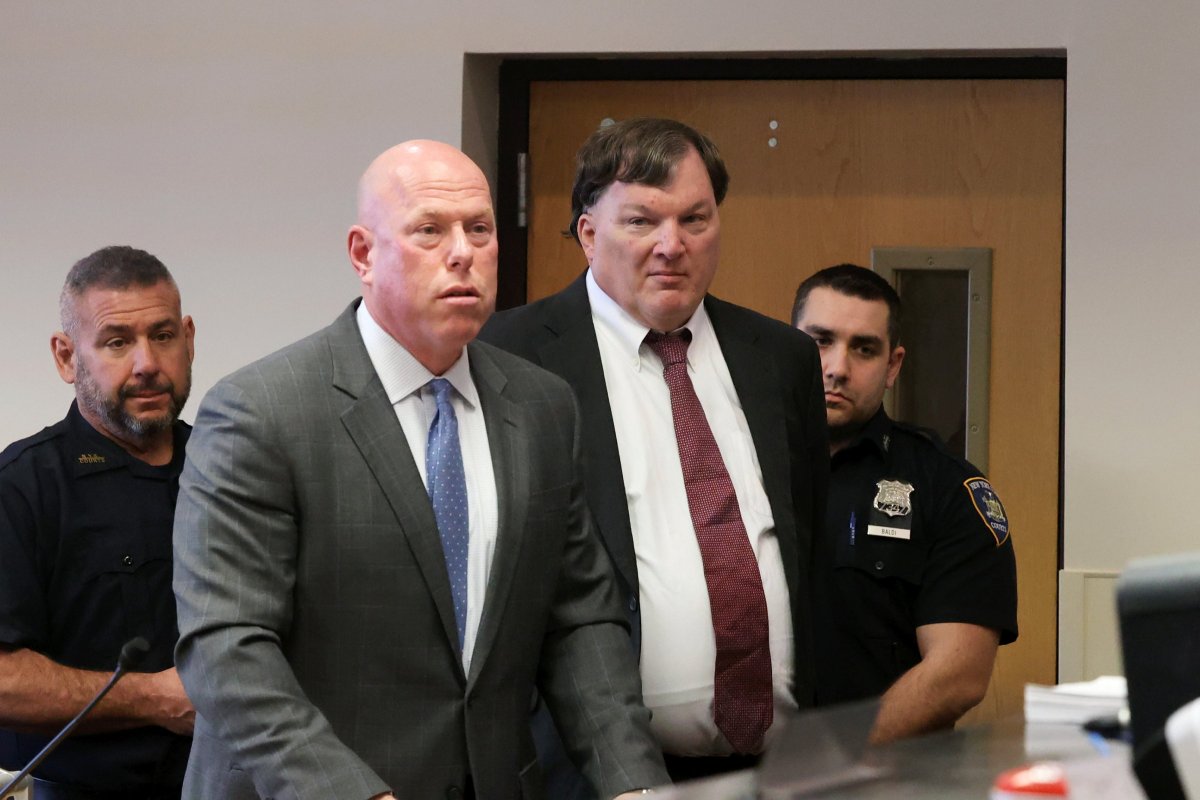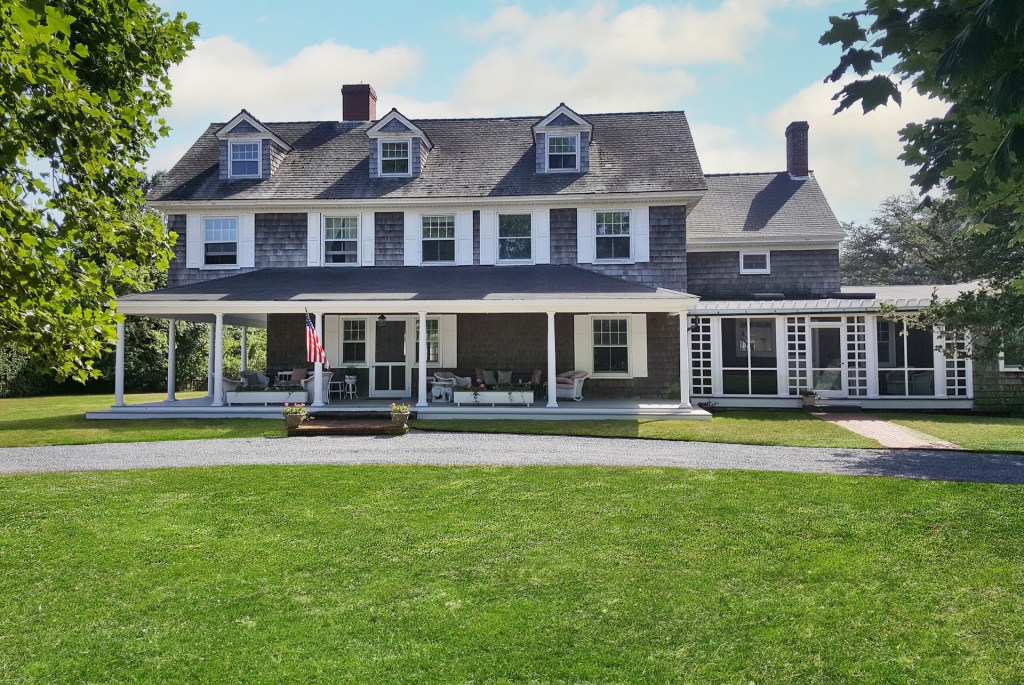Gun Fight: Two Shot at Deep Hollow Ranch During Booze Dispute

The only gunfight between rival gangs that ever took place in the Hamptons occurred at a ranch in Montauk one midnight. It was between five hijackers and eight rumrunners. An estimated 30 shots were fired. Two people were wounded before it was over and both were treated at around 4 a.m. by a Dr. David Edwards, who met them at his East Hampton office at that hour. After that, the injured were driven to a house at 72 Laurel Street in Patchogue, where they spent the rest of that night. The gunfight occurred over contraband liquor, about $10 million worth of it in today’s money. Two days later, state troopers came and, using crowbars and sledgehammers, smashed all of the illegal hooch to broken glass where it was stored in the west wing of the home and in garages and swamps around that ranch.
The ranch house where all this happened was the Deep Hollow Ranch, four miles west of Montauk Lighthouse, occupied that night by the Frank Dickinson family. Asleep at midnight were Frank and his wife Loretta, Frank’s father Phineas Dickinson Jr., his nine-year-old daughter, Eleanor, six-year-old son, Phineas, and his three-year-old son, Shank. The family worked as caretakers and managers of the ranch house and the 3,000 acres of ranchland that surrounded it. Cattle were raised on this land. There was a big barn, numerous trails, and pastures. A man named Arthur Benson had owned this house. But by this time, in 1924, he had passed away and his heirs were continuing the operation from afar. The Dickinsons were the hired help.
As it happened in those years, things had gotten very awkward in Montauk. It had to do with Prohibition and the fact that enormous amounts of excellent whiskey were being brought to America aboard freighters that dropped anchor outside the 12-mile limit off Montauk. The owners of about 40 fishing boats in docks on Fort Pond Bay fished by day as they had there for nearly 50 years, but by this time, also operated as rumrunners at night, bringing in cases of liquor to be hidden somewhere in Montauk until bootleggers from New York City would come out with big vans to take the stuff off. A lot of money was made by the Montauk fishermen at that time. Prohibition, by 1925, had been in effect for six years.
The Deep Hollow Ranch, of course, was the perfect place to store the liquor. It was in the middle of nowhere. (It still is. It is the main house in the Suffolk County Park at Montauk.) Frank Dickinson was offered $1.75 a case to store the stuff on the property. He’d be making money out of Prohibition, too.
Of course, “protection” had to be in place. It was provided by, amazingly, members of the New York State troopers. They knew the stuff was there. Dickinson would give some of the money he was being paid to have them keep an eye on things, too.
The knock on the door came at midnight. Frank woke up, and so did his father, Phin. This was not your usual time for visitors. And certainly it wasn’t a time for the state troopers. They came during the day, about once a week, politely, for their cut.
And yet, at the door, were five men, three pointing guns, one of whom was a state trooper. He showed his badge. He was State Trooper William Dalmadge. The others were not troopers, although one had been one. His name was Jeremiah O’Keefe. The others were two brothers, Thomas and Frank Smith of Patchogue, and another Patchogue man named William Shaber. Later, when Dalmadge was arrested, he told officers he knew Shaber as “Shader,” but did not know his first name.
“We’ve come to get some boxes,” Dalmadge said. He motioned to the vehicles behind them. They were a Ford truck and an Essex Touring Car. “Fill ’em up. Just tell us where they are. We’ll get ’em ourselves.”
At this point, Frank’s father Phineas, who had not come to the door, went through the house, told Loretta to keep the bedroom door closed and keep Shank still, and slipped out the back. Quietly, he got on a horse and rode off full speed to the Montauk fishing village on Fort Pond Bay four miles away to get help.
Frank Dickinson was held at gunpoint. There was nothing he could do. His five intruders began loading the truck. It was going to take well into the night to fill it up. Then it would be on to the Essex.
There have been several accounts about what happened around 3 a.m. It’s hard to say what’s true, but certainly Trooper Dalmadge, recovering from his wounds, told the most interesting version.
Dalmadge first knew there was something wrong when he heard a shotgun fired. It startled him. He raised his pistol and fired it into the air. Then he shouted to the others to stop what they were doing and get the hell out of there. They ran down to the half-filled truck, climbed in, started it up and headed down the driveway where they ran into an ambush of what he said was about 35 fishermen come to protect their liquor. Leading them, he said, was boat captain Charles Walker. Dalmadge and the others ducked down in the truck, fired back, but Tom Smith was hit in the head, then Dalmadge was hit twice, once in the back and once in the stomach. Men hauled him out of the car, ripped off his badge, took his gun and other trappings of his office, then threw him back into the truck and told the hijackers to get out. They did.
In East Hampton, as Smith was being treated, Dalmadge managed to phone the main trooper headquarters in Bay Shore. He had been out in Montauk on patrol, he told the man who answered, and he’d been ambushed by rumrunners. There was nothing he could do. They’d taken his badge and gun. They should send reinforcements.
Meanwhile, back at the ranch house, the angry fishermen milled around for a while, calmed down, and then called police constable John Gay in East Hampton to tell them there’d been a shooting at the ranch. Gay called the District Attorney’s office, and they woke up Suffolk County D.A. George Hildreth. He should come right away to East Hampton and the two of them would go out to Montauk.
As dawn was breaking, Hildreth and Gay made a turn to drive out to the ranch at the K of C building, but behind them, all of a sudden, was a Dodge Coupe, an oddity at that hour, which had a pretty woman and a young man in it, as they reported later. The Dodge Coupe pulled around them and went first up to the ranch, with the two law enforcement officers pulling up in time to see the boy go inside and the pretty girl coming out of a swamp by the car with what they said appeared to be a black eye. This has never been explained.
The two law enforcement officers were friends of the fishermen. They didn’t need to be told there were boxes of alcohol on the premises. But they wanted to be there when, as they truly expected, trooper reinforcements would be arriving from the State barracks in Bay Shore. They were right. An hour later, 15 troopers, headed up by Lt. Francis Lynch, pulled up and took charge. Lynch demanded the return of Dalmadge’s gun and shield. At first the fishermen said they took a lot of things off Dalmadge and said “these were presents from him.” They produced a hat, a cartridge pouch, a belt and a lanyard. But Lynch wanted the gun and shield. Nobody produced it. At this point they didn’t have a warrant. But the troopers remained.
Soon, one of the troopers Lynch had set off to get a warrant, returned with one signed by East Hampton Justice C. Lonis Edwards. This was at about 7 a.m. The request on the warrant read that Lynch “during the search [for the gun and shield] discovered what we believe to be liquor.” Some troopers saddled up Dickinson’s horses and rode off into the woods and swamps looking for hidden liquor boxes. They were not disappointed. Thousands of wooden boxes of liquor were found and the troopers began smashing them up. Lynch called for big trucks to come get the broken glass and boxes and casks. There would be, in the end, five huge moving van trucks to move it all to warehouses on Army bases up island.
Lynch ordered troopers to find Dalmadge. They went to his home in St. James that morning, but he wasn’t there. Then they learned he was resting up at the home of Helen Smith at 72 Laurel Street in Patchogue. He also ran a trace on the Essex. It belonged to her. But it had just been reported by her as a stolen car.
Meanwhile, the Montauk fishermen talked to the troopers openly about why this had happened. They had been happy to pay up to $500 a week for the troopers’ protection. They had no problem with that. But this was not troopers. It was hijackers, in the middle of the night. These were bad guys, interfering with a smooth-running operation. One of the fishermen told of a hijacker who stole $1,700 from a trooper named Pederson. The fishermen stole it back when the hijacker came to a stop in front of the K of C building and returned it to the trooper.
Lynch called Federal Prohibition Agents in Sayville, and C.R. Smith, William Schmeelk and their boss, John A. “Hawk Eye” Wilbur, came out to Montauk to “take possession” of the liquor cases and arrest Frank Dickinson on charges of “being in possession of alcohol.” They took him away. He would be released the next day on $2,000 bail.
The troopers stayed two nights at the Dickinson house. They essentially wrecked it. They smashed toys, furniture, beds, lamps, hunting guns, linens. They smashed about 2,000 boxes of liquor in the west wing and by the swamps and elsewhere and just left the broken glass everywhere. When they were finally gone, it took five men and two women three days to clean up the mess. Garden tools were taken, a hunting gun owned by a Mr. Prentice and several gold coins Loretta had hidden in a drawer under some clothes. One fishermen said that when the water ran low, they washed dishes in champagne.
Meanwhile, Lynch himself, on his way back to the troopers barracks in Bay Shore, stopped in to see the wounded Dalmadge in Patchogue. Dalmadge had this story that didn’t add up.
He had gone out to the ranch, he said, to retrieve the gun and shield taken from him in this gunfight with 35 rumrunners earlier. He couldn’t however explain the half-filled truck. And he couldn’t explain why he’d gone out there with others who were not only not troopers, but were well-known crooks from Patchogue. In the end, after telling Lynch it would be dangerous if he, Lynch, went to Montauk because the gunmen were “of the worst type,” he confessed. He was on a three-day pass from a barracks in New Rochelle and the former Trooper Jeremiah O’Keefe (who was now in hiding) had told him there was easy money to be made if he showed up at the ranch in uniform. Just take your uniform with you when you go on your three-day pass. Bring friends. And he, O’Keefe, would come, too.
In the end, Frank Dickinson pleaded guilty to being in possession of liquor and was ordered to pay a $500 fine. Then he was hustled over to the grand jury investigation to testify. He would later be a witness at trial, along with his father, Sheriff Biggs, Everett Petty and Bud King. But he essentially had gotten off.
None of the fishermen/rumrunners were arrested. But Trooper Dalmadge, ex-Trooper O’Keefe, Tom and Frank Smith and William Shaber were charged with burglary and larceny and were convicted and served jail sentences.
As a result of this sensational case, the Coast Guard organized and carried out an assault on rumrunners at the 12-mile limit the following week by what the Coast Guard called the “Dry Navy.” It consisted of 42 picket boats, 8 cutters bristling with weapons and 12 seaplanes borrowed from the Navy. This would be “the most formidable fleet ever assembled against rum running” the Brooklyn Eagle crowed. Of course, the rumrunners sailed off before the Dry Navy arrived, then came back after the Dry Navy left.
The local fishermen said this all caused a downturn in the rumrunning business, but they predicted it would pick back up when the Dry Navy went home, and of course it did. Prohibition remained in effect until 1933, eight years after these events.
Much of this tale comes from Shank Dickinson, who was three years old at the time of the shoot-out and likes to tell the story. He’s in his mid-90s. As for the rest, research was carried out by Maura Feeney at the Montauk Library and by this author reading back issues of both the East Hampton Star and the Brooklyn Eagle, available online. The shootout ran on the front page on five different occasions during April and May 1925.



